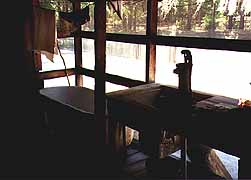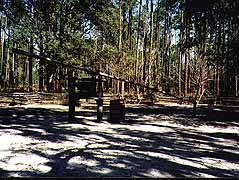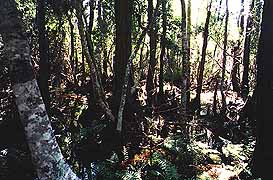The regrowth woods around Folkstone, Georgia, are rather dramatic. Vertical columns,
the red scaly trunks of the longleaf pines, stand in endless aisles
above acres of waist-high palmetto, spiky clusters of bright green
fans, and the shivering canopy of pompom needles casts dappled
shadows over everything. The peripheral animation driving through
such a stage set makes you tingle. Young plantation pines proving
there can be an organic industrial beauty.
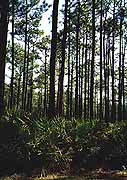
Pines & Palmettos
We followed the brown park signs to the gates of the Okefenokee,
not quite knowing what to expect. I learned how to read immersed
in a make-believe world inked on pages of newsprint: the Pogo
comics. Walt Kelly had conjured an imaginary swamp, full of ludicrous
characters, engaged in a slapstick rendition of politics as usual
in the 1950s. The jokes were over my head, of course, but the
visual comedy and the verbal Dee-light hooked me on words and
hardedge drawings for life. I wore my copies of the Pogo books
to tatters, reading and rereading as new levels of meaning awoke
for me, then I’d dug them out when Seth was little, and he’d done
the same, to the point of disintegration.
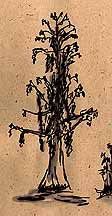
Swamp Cypress
Kelly’s Okefenokee was an airy luminous place full of fat giant
cypress and black waters, a barefoot boy’s paradise. At some level
I expected this real swamp to have winding passages between old
cypress, draped in vines and hung with Spanish moss, alive with
snake and gators and flashes of birdcolor.
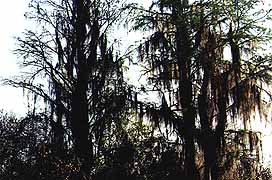
Moss
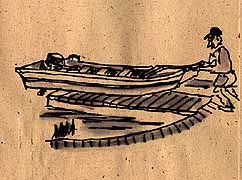
Rental Skiff
Instead there was an entry road through young pines ending in
a lot alongside a small marina basin in a scraggly mix of secondgrowth,
on the edge of a drowned jungle only 60 feet tall at the highest,
and sparse enough to let daylight through everywhere. We debated
renting a tinboat and outboard combo, or a canoe, but opted for
an hour tour so we could pump the guide for info.
The only tour customers at this early hour, we clambered aboard
the blue canopied johnboat and buzzed off into the Suwanee Canal.
The long straight waterway was clogged with family groups in canoes
and rental outboards, lying crossways and anywhichways on the
learning curve. Our guide turned out to be a shy young man from
Indiana who only knew his prepared lines, and could barely be
urged into saying them. He’d been trained to stop the boat before
speaking, so everytime we asked a question he’d idle down the
buzzer, and we herked and jerked along the canal.
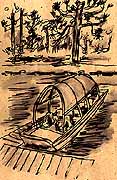
Tour Boat
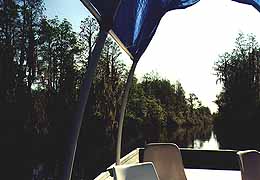
Along the Canal
Very disconcerting: the Okefenokee has been entirely logged off,
and is now preserved as a past devastation and a future promise.
Along the canal there’s a juvenile beauty strip of dense young
cypress, mixed with lesser swamp veg, and four foot gators every
100 yards or so, lying half submerged. All the old giants went
through the mill, a bonanza in cypress never to be seen again.
Now you can’t even cut the knees, which poke up their promises
through the lily pads.
Taking a side channel off the canal we crossed wide treeless expanses
of lily and golden club fields. Occasional “batteries”, or floating
masses of vegetation that look like terra firma, but would swallow
you up, are lodged at random. Grotesque solitary cypress clothed
in Spanish moss stood here and there, with great blue herons nesting,
egrets wingbeating by, and osprey diving. The sun began to bite
on our exposed surfaces, and the last imaginings of cool corridors
under ancient trees evaporated.
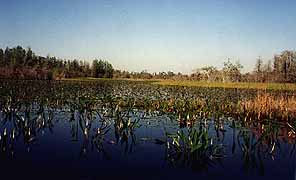
Golden Clubs
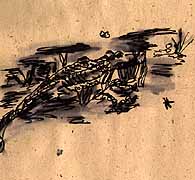
Albert
A new feeling arose. While a lingering sadness for the grandeur
of primal America stands wrapped in vines and moss on the edges
of this place, it is still a wonderland of exuberant greenery
and amphibious wriggling. It felt glorious to be in a humid sun-soaked
place in late March, a gentle breeze drying the sweat, and no
bugs! All the city intensity and highway haste sank down into
dark water until only its eyes were exposed.
(Memo #70)
March 22 Okefenokee Swamp
WHO? tourists, swampsquatters, loggers, alligator hunters
WHAT? 750 square mile swamp
WHERE? on the Georgia-Florida border
WHEN? now
HOW? boat or canoe
TOPICS: swamp ecology, forestry, logging, sustainable tourism
QUESTIONS: What kind of a swamp the Okefenokee?
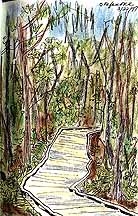
Okefenokee Walkway
(Peggy)
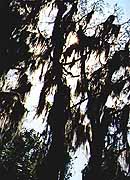
Moss
I was fooled. I expected huge trees blocking the sun. Dark expanses
of stagnant water with occasional shafts of sunlight. A dark,
heavy, humid environment with thick air. Maybe it’s more like
that in the summer. In March the swamp was lovely. We had a cool
breeze. The sun is hot, but we were mostly in shade. The bugs
apparently get bad after May, especially the yellow flies I was
told, but I got more bitten in downtown Charleston. The trees
just aren’t that big, because the whole area was logged off. So
the “swamp” was sunny and open.
The eastern gateway to the Okefenokee (near Folkston, Georgia)
is a drive through a pine forest, a pine and palmetto forest.
The palmettos are low palm plants - maybe three feet high. As
undergrowth around the big pines they are gorgeous. We drove in
to the information center on the old Suwanee Canal where we took
an hour long boat tour. The “dry” land around the information
site which looks like ordinary lawn, is all based on sandbags.
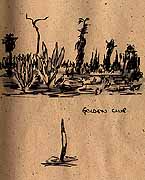
Golden Club
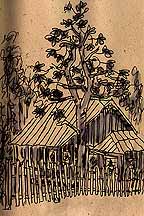
Swasmpsquatter's
Shack
Groups of canoeists were gearing up. There are several boat loops
through the swamp. You can book overnight guided tours too. Our
tour boat had to navigate around perhaps thirty two-person canoes.
The guide grumbled. We motored slowly down the canal for several
miles. The woods were all small trees (cypress and black gum and
others) and the “land” was islands that the guide said you fall
through if you try to walk on them. On each side the swamp opened
up into “prairies”, vast expanses of grass and waterlilies and
mosses. We saw white ibis and great herons (a nest too) and -
yep- alligators of various sizes, near and far.
Gators are now “threatened” rather than “endangered” (I’m not
sure how this is determined). I didn’t realize that they live
80-100 years. When we returned our guide said we should go “ see
George up by the visitors center”. Sure enough, George - an elderly
fourteen footer - was sunning himself. We saw another gator on
our later boardwalk tour of the swamp who lazily swam across a
pool and then chomped a fish. It was a little more eerie to see
an eight foot alligator casually coming out of the ditch by the
road as we drove by. I was glad we weren’t bicycling as others
were. There is a current news story about a gator killing a toddler
here in Florida. Everyone here stresses how unusual this is(!).
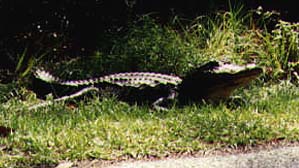
Gator
